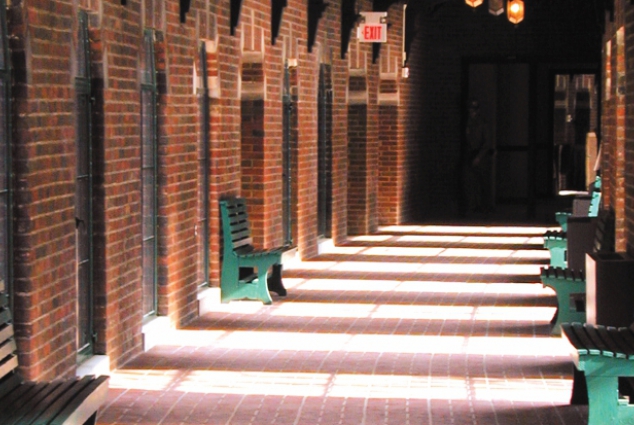Catholic sisters have always responded to the pressing need of the historical moment, whether for hospitals, orphanages, and schools, or for peace, justice, and civil rights. Today we live in a world where, in the words of Pope Francis, “any genuine attempt by groups within society to introduce change is viewed as a nuisance based on romantic illusions or an obstacle to be circumvented.” It is in this context that vowed Catholic religious—accustomed to working on the fringes for unpopular causes—have been quietly leading the charge for environmental sustainability.
The “green sisters” are various Catholic religious orders that have integrated Catholicism with environmentalism. Some are contemplatives who run retreat centers for prayer and reengagement with nature, while others are activists who travel the world, teaching and ministering to those suffering the effects of climate change. As the Sisters of Earth—their informal network—they come together for international conferences to share how different regions have been impacted by environmental degradation and discuss how they can work with indigenous cultures to seek solutions.
The green sisters have been doing this work for 20 years. But while Popes Benedict XVI and John Paul II expressed concern about the looming ecological crisis and its implications for humanity, it was Pope Francis who affirmed the value of these women’s vocation with Laudato Si’. Sisters, Servants of the Immaculate Heart of Mary Sister Janet Ryan says, “When Francis writes, ‘We are faced not with two separate crises, one environmental and the other social, but rather with one complex crisis which is both social and environmental,’ and when he says that these problems ‘demand an integrated approach to combating poverty, restoring dignity to the excluded, and at the same time protecting nature,’—well, that’s what we’ve been talking about all along.”
A sense of vocation
Far from fading into obscurity, shuttering their motherhouses, or turning off their lights, the green sisters have gone outside, planted community gardens, and installed solar panels. While the vocational crisis is all too real—the average age of vowed religious increases every year—the Sisters of Earth have found new energy and purpose in the environmental movement, and many of their communities are thriving, brought together with shared environmental and religious commitments.
The Sisters, Servants of the Immaculate Heart of Mary (IHM) community in Monroe, Michigan is one such group of women religious. In better times, the sisters ran a college and several high schools in southern Michigan. But by the late 1990s they had sold much of their property, and their Motherhouse, a 376,000-square-foot Depression-era behemoth, required either a complete overhaul or demolition. Their situation was one all too familiar for many American Catholic religious. However, the community reacted not by selling their land or closing the building but by becoming pioneers of eco-renovation.
“What had begun as a young, college-driven teaching community had become a senior community,” says Ryan, who served as a member of the IHM Leadership Council from 2000–2012. Selling the land and razing the house to create a smaller, cheaper, more manageable home for an aging population seemed like the most practical choice for the congregation.
But while this might have been the easier choice, the sisters eventually decided it wasn’t the best decision for their future—or for the future of the community they served.
Monroe, like so many American cities, suffers from factory closures and the loss of major employers. Ryan says about a quarter of its residents live below the poverty line and, at the time, the IHM congregation was among the top employers in the region. According to 2010 census data, the campus employed 265 administrators, groundskeepers, nurses, and other support staff.
“We’d sold off so much of our property over the years,” says Ryan. The sisters had owned and operated extensive local farms until 1976, and their land, along with the house they lived in, was among their greatest assets. In addition, the goal of the IHM sisters is to educate people on environmental issues and to foster the relationship between God and the entire earth community. “We wondered instead if we could better use these resources to live out our mission,” she says.
The more the sisters thought about it, the more it seemed like selling the property meant going against this mission. Razing the building would mean adding tons of concrete, brick, and virgin wood to a landfill, and selling the land would mean they’d have no control over how it might be used—or misused. So they began to look for a more comprehensive solution, one that would not merely serve their aging members but would also benefit the local community and restore and protect the health of the land for future generations.
The sisters did their homework. They found the building was sturdy and could last another hundred years. Their bedrooms, all with private baths, could ultimately be converted into apartments and rented to the public. Much of the original materials could be reused—from the carpet and the windows to the wood doors and marble floors. By installing green systems for heating, cooling, and plumbing, they found they’d pay more upfront, but could make long-term investments in the health of the land and the population as well as the financial health of the congregation.
After two years of meetings, research, and discernment, the IHM sisters decided that renovation, though initially more expensive, was more ecologically responsible. Many of their projects, like the installation of a geothermal heating-and-cooling system and recycled water (gray water) lines with natural purification via constructed wetlands, were the first of their kind in the area. The sisters learned alongside the firms they hired. Sometimes their mistakes were costly—one firm designed their geothermal system based around a warm climate, neglecting to take cold Midwestern winters into account, causing the whole plan to be scrapped.
But the project paid off: When the sisters moved back into their Motherhouse in 2003, their home had become a living laboratory for sustainability, and it remains one of the most significant and influential green projects in the Midwest.
It wasn’t cheap and it wasn’t easy; in addition to the financial cost, the sisters encountered skepticism from the city and their neighbors. They had to challenge existing codes and restrictions on everything from the height of their outdoor lighting poles (the city required 15-foot poles, while the sisters knew that a 20-foot pole is more efficient) to the length of their prairie grass (it should be cut only once a year to provide an optimum natural habitat and water filtration system, but the city prohibited grass more than 2 inches high). Their neighbors worried that gray water would pollute the neighborhood, that it would stink, or that their children would lose access to the free parkland they enjoyed.
“We knew we had to invite people in, educate them,” Ryan says, which is what the IHMs—a teaching order—have always done. Ultimately, their determination to reinvent themselves transformed both their community and the city outside their walls. “We changed how the city does things,” Ryan says.
The IHM campus now hosts an organic community garden, where locals tend their own plots and learn about healthy, sustainable eating. La-Z-Boy, Inc., which purchased 120 acres of IHM land, agreed to construct a green-certified building with a geothermal system and to protect the nearby oak woods. Neighboring Sterling State Park has since planted indigenous prairie grasses, and some of the local residences have installed gray water systems for lawn watering. The sisters have become sustainability educators and are leading efforts in the area to go green. The Motherhouse is an eco-learning center, where the public can go to learn about geothermal heating and cooling, gray water systems, even lighting efficiency and how to create a more uplifting environment with access to nature, natural light, and natural and recycled products. In addition, Ryan is a chaplain at Mercy St. Vincent Hospital in nearby Toledo, Ohio, where she is working to create a “creation care team,” sharing her experience and knowledge of best practices to help the hospital become more environmentally responsible.
More Catholic than tree hugger
Their renovations and creation of an educational center immersed within the wider community required the IHM sisters to rethink how they lived both their mission and their spirituality. They often faced criticism within the church, as they redefined what it means to live out a concern for the poor. “We were called nature worshippers, tree huggers, told we’d lost our way,” says Ryan. “But we see our commitments as a key component of our vocation—the transformation of society through education, seeking social justice.” The sisters began to see a commitment to the care of the earth as intrinsically connected to the care of the poor.
Far from infusing Catholicism with a tree-hugging worship of the earth, the sisters apply traditional Catholic social teaching to what they perceive as the most pressing crisis of our time. “We see the protection of the earth as inseparable from the protection of the poor,” says Ryan. Going green is just another way to live out the scripture that has always informed their mission—to bring “glad tidings to the poor” (Luke 4:18).
The IHM sisters may have been criticized for their understanding of who exactly is meant by “the poor,” but they’re not alone in their beliefs. The social justice implications of the ecological crisis are a persistent theme of Laudato Si’. Ryan echoes Pope Francis when she emphasizes that “the poor suffer inordinately from the problems we have created by treating the earth as a commodity for our disposal.” And this isn’t just a problem for developing countries. Ryan mentions the water crisis in nearby Flint, where lead-contaminated river water has caused serious health concerns for the local children. “The most polluted areas on earth are where the poor live,” says Ryan.
A legacy of eco-Catholicism
Pope Francis may be changing the conversation around ecology and social justice within Catholicism, but talk to a green sister about her inspiration, and she’s more likely to mention Miriam MacGillis or Thomas Berry than Pope Francis or even St. Francis. MacGillis is a Dominican sister and director of one of world’s first eco-learning centers, Genesis Farm, in Blairstown, New Jersey. She also created one of the country’s first community-supported agriculture (CSA) programs in 1988. Thomas Berry, who inspired MacGillis, was a Passionist priest who wrote extensively on ecology and history. He referred to himself as an “earth scholar” and believed that understanding the earth was essential to understanding ourselves as humans.
Sister MacGillis often shocked the young people who flocked to her countercultural farm, few of whom expected to find a Catholic sister at the helm. Despite galvanizing the women religious she taught, many of whom were seeking new ways to live out their vocations, Catholic leadership questioned her orthodoxy. She, like the IHM sisters, came under fire for her ideas about God’s presence in creation and her belief that understanding the earth can help us understand our relationship with God.
MacGillis has been incorporating an ecological spirituality into her work for more than 40 years—far longer than Pope Francis’ encyclical has been around. But Laudato Si’ goes far in defending the spirituality of MacGillis and other green sisters. Citing the “awe-filled contemplation of creation” that his namesake St. Francis of Assisi talks about, Pope Francis argues that to recognize the divine in nature does not signal a drift toward worshipping the earth, but is rather a proper understanding of cosmology and authentic Christianity. Such an understanding compels us as Catholics to protect, rather than dominate, the natural world.
Berry, MacGillis, and Pope Francis were all influenced by the work of Jesuit scientist and philosopher Pierre Teilhard de Chardin, who believed evolution is not only a physical and scientific process but also a spiritual progress toward union with God. Teilhard’s poetic interpretations of the Genesis creation stories and his writings on the doctrine of original sin once made him a controversial figure in the church, but both Popes John Paul II and Benedict XVI wrote approvingly of Teilhard’s work. By 2009 Vatican spokesperson Federico Lombardi said, “no one would dream of saying [Teilhard] is a heterodox author who shouldn’t be studied.”
Teilhard’s influence and his ideas about human progress and evolution are clear in Laudato Si’. Pope Francis argues for the rejection “of every tyrannical and irresponsible domination of human beings over other creatures,” and writes that “the ultimate purpose of other creatures is not to be found in us. Rather, all creatures are moving forward with us and through us towards a common point of arrival, which is God, in that transcendent fullness where the risen Christ embraces and illumines all things.”
The oldest spirituality in the book
“I had always been committed to social justice and human rights,” says Dominican Sister Patricia Siemen, an adjunct law professor and director of the Center for Earth Jurisprudence at Barry University School of Law in Orlando, Florida. “I went to law school to provide support for underserved communities who were experiencing discrimination.” But after encountering MacGillis and Berry—and through them, the works of Teilhard—her worldview expanded. “If God is embedded in the natural world, then all creation is sacred,” she explains. “Nature can no longer be treated as a thing or property that we humans have a right to dominate and exploit. We need to be in right relationship and balance.”
Siemen went on to study the Catholic mystical tradition, where she found an appreciation for the presence of the divine in nature. She cites in particular the German mystics Meister Eckhart, who wrote of creation as an overflowing of God’s spirit, and Hildegarde von Bingen, who connected the health of the natural world to the health of the human body.
Siemen is also inspired by biblical stories, which she sees as having a strong connection to the natural world. Jesus’ time in the desert, on the mountain, and in the garden of Gethsemane are all a call to contemplative prayer in nature. Even the biblical stories of floods and plagues and famines link environmental health and human well-being—or both the physical and spiritual.
But Siemen says that the average Catholic hasn’t been formed in this kind of thinking. “Mysticism and contemplation of nature are dimensions of our Catholic identity, but they aren’t doctrinal,” she says. “You don’t hear this in homilies in your local parish.”
Again, this is changing with Laudato Si’. One of the encyclical’s most striking features for Siemen and other green sisters is that Francis’ urgent (and official) call to environmental action is firmly rooted in the language and spirituality of the Catholic mystical tradition that has so inspired these women religious. Though Francis’ predecessors acknowledged the ecological crisis and our obligation to care for the earth and its people, Siemen says Laudato Si’ “was the first time in 40 years that the official church was speaking in a language that I resonated with. It was profoundly affirming.”
“When I first read [Laudato Si’] through, I sat and wept,” Siemen says. She wrote in a reflection for the Global Sisters Report, “This is a breakthrough moment for people who are working to advance legal recognition of nature’s rights to exist and flourish.”
Siemen hopes that more American Catholics will directly engage the mystical dimension of the encyclical. She suspects that the lack of respect for the care of the earth stems not merely from ignorance and corporate greed but in part from a fear of nature worship—the suspicion that reverence for creation is something other than a natural consequence of reverence for the creator.
Spreading the news
This misunderstanding about a vocation to care for the planet is why Dominican Sister Caroline Sullivan of Sinsinawa, Wisconsin has made it her mission to invite people back to a spiritual relationship with the land. She says, “We’ve lost our connection to nature,” pointing out that most of us have little to no experience of growing our own food or caring for our own land. Instead we spend almost all our time indoors, and “the earth no longer feels like home.” This makes it easy to ignore our responsibility for its care and keeping, she says, but it also damages our spiritual health. “The experience of nature is one of the ways we come to know our maker and hear his voice,” says Sullivan.
She first noticed that damage when she was a principal at a grades K–8 school.
“I couldn’t shake the feeling that we were all sick—me, the students, their parents—all of us,” Sullivan says. “We were disconnected from our roots and we were spiritually starving.” She thought she was having a crisis of vocation and even considered leaving religious life. Instead, while receiving spiritual direction, she began to dream of a place where anyone—regardless of age, faith, or economic status—could come to simply spend contemplative time in nature and grow and eat wholesome food.
But when she first presented the idea of a sustainable, contemplative nature retreat to her religious community, it didn’t garner much enthusiasm. They gave their blessing and even their name, but she had to go it alone. They gave her three years to make it work.
When she finally found a donor and some property located south of Green Bay, outside of the small village of Denmark—a broken-down silo, farmhouse, and granary, all constructed in 1890—she says another sister asked her, “You’re going to buy that godforsaken place?”
But where others saw nothing, Sullivan imagined a thriving vegetable garden, grazing chickens, a barn full of animals, and guests gathering around a communal table to share a meal grown from the broken ground. Sullivan worked to raise the money to renovate and manage the center, which she named “The Bridge-Between”—a nod to Catherine of Siena’s description of Jesus as the bridge between heaven and earth. Over the years she received grants to install geothermal heating and solar panels. She found contractors willing to donate time and goods.
The Bridge-Between now thrives in its 29th year as an award-winning sustainable homestead and retreat center. It offers individual and group retreats, spiritual direction, therapeutic massage, garden shares, and daily lunch and dinner. It also hosts the occasional confirmation or Rite of Christian Initiation of Adults class from the nearby Diocese of Green Bay. The staff teaches workshops on “intentional eating,” preparing and enjoying simple food grown with minimal waste and maximum appreciation. Farm-to-table eating has become trendy and expensive, but here eating intentionally is not about indulgence, it’s about standing with the poor. “What other people would throw away, we use and celebrate,” says Sullivan. The center also teaches healthy cooking and eating with food pantry staples.
Unlike many of the other green sisters, Sullivan expresses no surprise or relief over the current focus on the environment. She says, “I think what Pope Francis has said is great, and I hope it will change lives.” But she seemed a little surprised about all the fuss over Laudato Si’. She’s never felt there was a conflict between Catholicism and a commitment to the environment, or that there was any question that taking care of the earth is the right thing to do. “How I treat creation matters, because how I treat creation is how I’m going to treat myself and how I will treat another person,” she says. “We should treat all life with dignity.”
Living simply, serving others, and expressing love for God and neighbor by caring for creation in all its forms—like the other green sisters, Sullivan may be on the cutting edge of an ecological revolution and, with the publication of Laudato Si’, of official church teaching. But she’s also showing us that this “new” way of being Catholic isn’t really new at all.
This article appears in the April 2016 issue of U.S. Catholic (Vol. 81, No. 4, pages 12–18).
Photo by Jeffrey Ceo, LNHA















Add comment